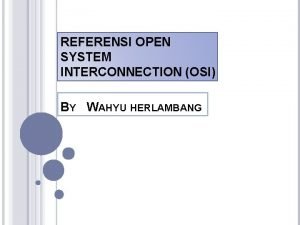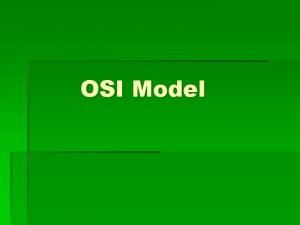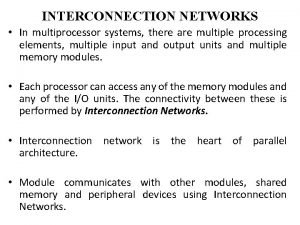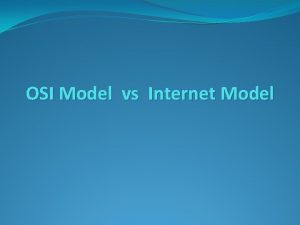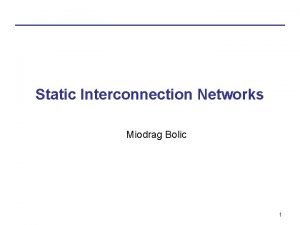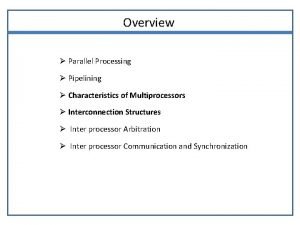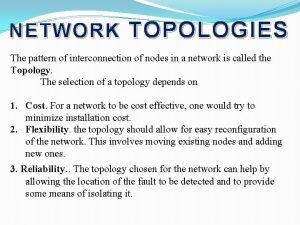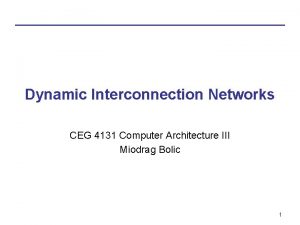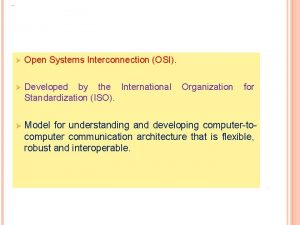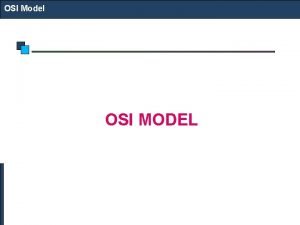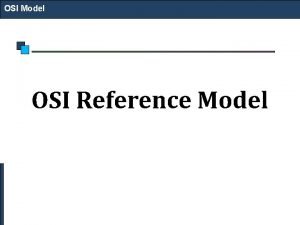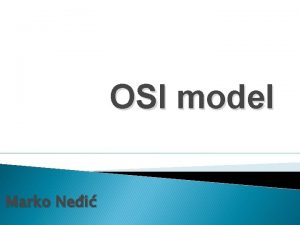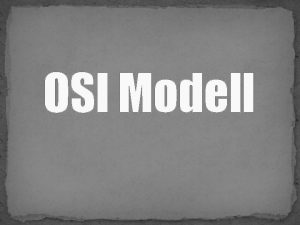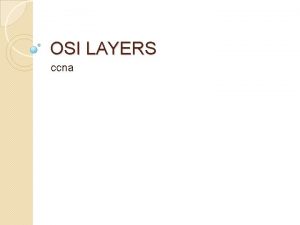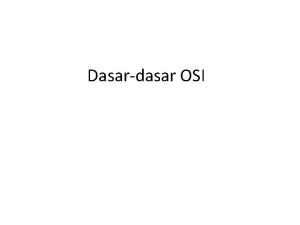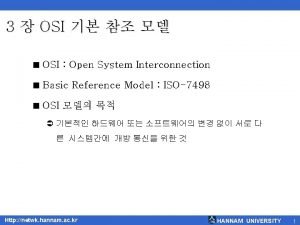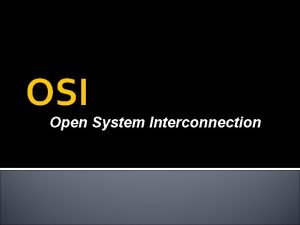OSI Model Open Systems Interconnection OSI is a











- Slides: 11

OSI Model Open Systems Interconnection (OSI) is a set of internationally recognized, non-proprietary standards for networking and for operating system involved in networking functions. 7 Layers 7. Application Layer 6. Presentation Layer 5. Session Layer 4. Transport Layer 3. Network Layer 2. Data Link Layer 1. Physical Layer

LAYER 7 – The APPLICATION Layer • The top layer of the OSI model • Provides a set of interfaces for sending and receiving applications and to use network services, such as: message handling and database query processing • Responsibility: The application layer is responsible for providing services to the user.

LAYER 6 – The PRESENTATION Layer • Manages data-format information for networked communications (the network’s translator) • For outgoing messages, it converts data into a generic format for network transmission; for incoming messages, it converts data from the generic network format to a format the receiving application can understand • This layer is also responsible for certain protocol conversions, data encryption/decryption, or data compression/decompression • A special software facility called a “redirector” operates at this layer to determine if a request is network related on not and forward network-related requests to an appropriate network resource

LAYER 5 – The SESSION Layer • Enables two networked resources to hold ongoing communications (called a session) across a network • Applications on either end of the session are able to ex hange data for the duration of the session This layer is: • Responsible for initiating, maintaining and terminating sessions • Responsible for security and access control to session information (via session participant identification) • Responsible for synchronization services, and for checkpoint services

LAYER 4 – The TRANSPORT Layer • Manages the transmission of data across a network • Manages the flow of data between parties by segmenting long data streams into smaller data chunks (based on allowed “packet” size for a given transmission medium) • Reassembles chunks into their original sequence at the receiving end • Provides acknowledgements of successful transmissions and requests resends for packets which arrive with errors • The transport layer is responsible for the delivery of a message from one process to another.

LAYER 3 – The NETWORK Layer • Handles addressing messages for delivery, as well as translating logical network addresses and names into their physical counterparts • Responsible for deciding how to route transmissions between computers • This layer also handles the decisions needed to get data from one point to the next point along a network path • This layer also handles packet switching and network congestion control

LAYER 2 – The DATA LINK Layer • Handles special data frames (packets) between the Network layer and the Physical layer • At the receiving end, this layer packages raw data from the physical layer into data frames for delivery to the Network layer • At the sending end this layer handles conversion of data into raw formats that can be handled by the Physical Layer

LAYER 1 – The PHYSICAL Layer • Converts bits into electronic signals for outgoing messages • Converts electronic signals into bits for incoming messages • This layer manages the interface between the computer and the network medium (coax, twisted pair, etc. ) • This layer tells the driver software for the MAU (media attachment unit, ex. network interface cards (NICs, modems, etc. )) what needs to be sent across the medium • The bottom layer of the OSI model • The physical layer is responsible for movements of • individual bits from one hop (node) to the next.

Summary

What is a protocol? • A protocol is a collection of rules and procedures for two computers to exchange information • Protocol also defines the format of data that is being exchanged 10

TCP and UDP TCP – Transmission Control Protocol • TCP is a connection-oriented protocol • Does not mean it has a physical connection between sender and receiver • TCP provides the function to allow a connection virtually exists – also called virtual circuit • TCP provides the functions: • Dividing a chunk of data into segments • Reassembly segments into the original chunk • Provide further the functions such as reordering and data resend • Offering a reliable byte-stream delivery service 11
 Open system interconnection reference model
Open system interconnection reference model Model open system interconnection
Model open system interconnection Osi modle
Osi modle Interconnection networks in multiprocessor systems
Interconnection networks in multiprocessor systems 영국 beis
영국 beis Osi model vs internet model
Osi model vs internet model Miodrag bolic
Miodrag bolic Chordal ring
Chordal ring Multiprocessors are classified as
Multiprocessors are classified as Star topology disadvantages
Star topology disadvantages Types of interrupt in computer organisation
Types of interrupt in computer organisation Dynamic interconnection network in computer architecture
Dynamic interconnection network in computer architecture

